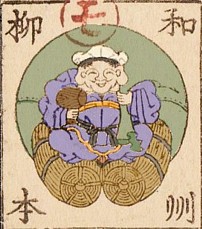JAPAN - DAIKOKUTEN
Daikokuten

One of the neatest collectible currencies in the world is Japanese Hansatsu. These banknotes were issued during the Edo Period (1603-1868), but there are similar designs issued before the Edo period and after the Edo period, during the Meiji Restoration, which restored Imperial Rule to Japan.
During the period of Japanese history from 1185-1603, Japan was ruled by the Emperor, but his power was not absolute. In reality, Japan was actually controlled by powerful Daimyo, (feudal lords) and Shoguns (warlords). This period has been divided up into separate periods of rule based on who was in control at the time.
After winning the Battle of Sekigahara in 1600, Tokugawa Ieyasu became the supreme ruler over Japan. He organized all the Daimyo’s into about 300 Han, a type of fief, or domain, from which he demanded loyalty. Those who were his enemies had their houses destroyed and their lands taken. Those who were loyal, he granted powerful positions to in the Han’s.
The Han’s were able to produce what were called Han-Satsu, a type of banknote similar to notes released previously by private issuers, but had since been removed from circulation. Hansatsu were issued in the different han’s and they circulated primarily within the han they were issued in, though there were a few exceptions. Hansatsu were based on the gold, silver and copper coinage of the time, but there were some that that were exchangeable for commodities such as rice and fish. In 1707 the controlling Tokugawa Shogunate banned the use of paper money, due to abuses of the system. However, in 1730, the practice of issuing Hansatsu was officially resumed.
When Tokugawa Yoshinobu resigned in 1867, the result was the Boshin War in January of 1868, in which the Shogunates forces were defeated and the Emperor declared himself to be restored to power. This period is known as the Meiji Restoration. At this time the government began an exchange program for people to turn in their Hansatsu for the new national currency called the Dajoukansatsu, which was the first banknote issued by a central government in Japan. This was met with reluctance, however, and the exchange was extended and ran until 1879.
Hansatsu notes are vertically printed and narrow, which has garnered them the nickname of ‘Bookmark Notes’ by some. The notes have many different designs and motifs, and are usually filled with the Japanese Kanji script both in printed and handwritten form. One of the more prevalent design features is that of a corpulent man standing on two barrel shaped rice bales, and carrying an oversized sack over his shoulder. These depictions are of the Daikokuten, one of the Shichi Fukujin, or Seven Gods of Fortune. Originating from the Buddhist faith in India, where he was known as Mahakala and was a fierce warrior god. Towards the end of the fifth century, he was ensconced in Buddhism, and he made his way to Japan by the eighth century where, over time, he lost his fierce ways and became a chubby, happy man. Renamed Daikokuten, he adopted a magic mallet, a large treasure sack, bales of rice, and became the god of wealth, happiness, farming, and of course, good fortune. He rapidly grew into a favorite deity throughout Japan.
His association with agriculture has him depicted almost always standing or sitting on two rice bales. This has also made him a favorite deity for cooks and kitchens. Tradition also has it that the main pole in a house is often called the Daikokuten pole, meant to support the house with good fortune.
The oversized sack of treasure has in it three items, in abundance: Wealth, Wisdom and Patience. The magical wooden mallet is said to be able to grant whatever wish you want when it is struck on the ground, and when shaken, coins will magically appear to fall out of it. The mallet contains a wish granting jewel, called the Hoju, that is a special symbol of power in Buddhism. The Hoju is said to be able to grant wishes, bring calm, and give understanding of the Dharma, or Buddhist law. The Dharma is also considered to be wealth in Buddhist teachings. The jewel has also been said to contain the sacred ashes of the Buddha himself. The mallet can also be seen with three jewels in a flame, or a single pointed flame. The three jewels and flame are, along with rice, powerful fertility symbol. On Hansatsu notes, these jewels can most often be seen on the ends of the rice bales.
Daikokuten is somtimes depicted with three heads, and is then known as the Sanmen Daikoku, which is depicted to show him as the protector of the three Buddhist “Treasures”: Buddha himself, Law and Buddhist disciples. This depiction of him was quite popular during the Edo Period in Japan.
Below are a few images of Hansatsu notes with Daikokuten and Sanmen Daikoku.





